|
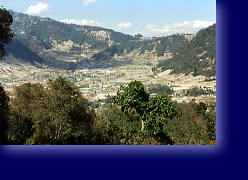
High above the hamlet of San Martín Sacatepéquez,
a lagoon lies
in the cone of
an inactive volcano named Volcán Chicabál. Chicabál's
neighboring mountains are Siete Orejas
("Seven Ears")
and Santa Maria. I
heard about the laguna yesterday, and as is becoming more and more frequent on this journey,
picked up early this morning and went.
San Martín is about 40 minutes by bus out of Xela, which
is the ancient indigenous name for Quetzaltenango, the second largest city in Guatemala.
It sits at the bottom of a small, steep-sided valley at an elevation higher than the 2,335
meters of Xela. Farms fan up the valley's sides to forest-capped mountains, one of which
is Volcán Chicabál. Clouds scoot quickly above this landscape, getting snagged on
those green peaks.
I was the only one to get off the bus when it pulled into
the village. The driver circled and disappeared in a cloud of dust around a mountain up
the dirt road we had come down. San Martín is one of the smallest towns I have visited
and only a few locals were out and about. I approached two men standing stiffly at the
counter of a tienda and asked the way to the
Laguna Chicabál. They did not respond, and I
guessed that perhaps they did not speak Spanish. I finally found a young boy who seemed to
understand and pointed in the direction of the mountain closest to the outskirts of town.
I had heard from people back in Quetzaltenango that the trek was over two and one-half
hours straight up the side of the volcano.
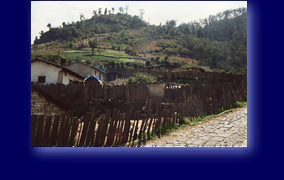 Following the boy's direction, I set out down a narrow,
dirt and cobblestone lane lined with rough, uneven fences surrounding rugged houses and
well-kept gardens. Children scampered out of sight when they spotted me coming, only to
peek through shaded doorways or from behind fences. The women quickly moved indoors and
usually were not seen again. It became a game with the young ones. They would hide until I
passed by, searching for the little faces that would suddenly appear. I laughed, said,
"¡Buenos Dias!" and waved. They smiled and, more often than not, waved
back. The lane meandered between houses and gardens like a dry natural streambed and
passed through some farmland. I found the dirt and gravel road that began a steep ascent
up the side of the mountain. On the way up, houses were pitched on the precipitous land of
well-tended, green farms. Barefoot men with heavy loads of firewood on their backs
literally ran past me down the sharp decline of the road. Following the boy's direction, I set out down a narrow,
dirt and cobblestone lane lined with rough, uneven fences surrounding rugged houses and
well-kept gardens. Children scampered out of sight when they spotted me coming, only to
peek through shaded doorways or from behind fences. The women quickly moved indoors and
usually were not seen again. It became a game with the young ones. They would hide until I
passed by, searching for the little faces that would suddenly appear. I laughed, said,
"¡Buenos Dias!" and waved. They smiled and, more often than not, waved
back. The lane meandered between houses and gardens like a dry natural streambed and
passed through some farmland. I found the dirt and gravel road that began a steep ascent
up the side of the mountain. On the way up, houses were pitched on the precipitous land of
well-tended, green farms. Barefoot men with heavy loads of firewood on their backs
literally ran past me down the sharp decline of the road.
* * *
Some
of those men wore the traje (traditional clothing) of this region: a thick, unbleached wool
tunic that hangs to the knees with a slip-like undergarment hanging four inches below its
hem. The visible border of the undergarment is a brightly-colored, woven pattern in red
and blue. The tunic has short, wool sleeves, and attached half way between the shoulder
and elbow, a long, puffed sleeve. This billowy addition is the same type of woven material
as the border of the undergarment, but in different shades of red. The sleeve is gathered
at a wide wristband; finished cord-like ends are tied into a knot, closing the sleeve at
the wrist. The tunic is cinched at the waist with a very long, wide piece of cloth that is
a mixture of red and orange. This faja is wrapped around the body several times and
tied in a bow at the back. The remainder of the faja hangs down flat against the
tunic, reaching to its hem. Later I would see simply and immaculately dressed men of
obvious means who also wore shoes and hats.
* * *
The
road continued upward at a very steep grade. Dwellings thinned out and
finally became non-existent. I was alone in this sweeping tilted world of
marvelous views across the valley. Due to the increasing altitude, I stopped
more and more frequently to catch my breath. Hiking at an incessantly steep
angle, I could hear my heart pounding, laboring to deliver oxygen in the
thin air. I kept pushing myself to move on, but had to keep stopping for
thirty seconds or so to steady myself. During one of the dizzy spells that
were coming more often as I trekked higher, I began laughing, imagining
Julie Andrews singing that the hills were alive with the sound of music--only in Spanish.
By this time, the climb had been steady for nearly two
hours. Sounds of a vehicle began drifting up the road, and in another few minutes, a
four-wheel-drive truck crawled up this unbelievable grade. It came to a halt and the
driver offered a ride. I gratefully accepted, having trudged and panted almost constantly
since I left San Martín. The driver's name was Faustino and was on his way to work. This
made no sense to me as I jumped in-- where could he be going, since I had seen nothing but
rugged mountain and trees for well over an hour? The drive that took ten minutes would
have taken a very hard thirty to hike; it was the last stretch before reaching the top of
the mountain. We crested the peak and descended the other side, stopping a couple of
minutes later. Acres of sharply angled fields covered the mountainside. A few groups of
men were spread out, working down on the slopes. They looked like mountain goats on the
sideways terrain. Smiling broadly, they waved and called out their greetings. From the
road above them, we waved back, looking down across the fields. The valley far below could
not be seen and, in the distance, other mountains, checkered with farms between forested
areas, shot up into the moving clouds and sky.
 I thanked Faustino and waved good-bye to the men. He said
that the top of the volcano was a little farther on. I laughed and asked what "a
little farther on" meant. He joked about it, saying, "a little farther, that's
all." I told him I live at sea level and that for me "a little farther
on" might be much more than "a little." He pointed down the road, which
headed to a tiny, shallow valley between the mountain we were on and the cone of the
volcano. Another mountain. Sweating profusely and light-headed, I continued onward,
actually peaceful and happy to be there alone. After crossing a few acres of maize fields
between the two mountains, another relentlessly steep grade began. The road narrowed to a
wide path, narrowing more and more as I reached the crest of the volcano and finally began
my descent to the lagoon. I thanked Faustino and waved good-bye to the men. He said
that the top of the volcano was a little farther on. I laughed and asked what "a
little farther on" meant. He joked about it, saying, "a little farther, that's
all." I told him I live at sea level and that for me "a little farther
on" might be much more than "a little." He pointed down the road, which
headed to a tiny, shallow valley between the mountain we were on and the cone of the
volcano. Another mountain. Sweating profusely and light-headed, I continued onward,
actually peaceful and happy to be there alone. After crossing a few acres of maize fields
between the two mountains, another relentlessly steep grade began. The road narrowed to a
wide path, narrowing more and more as I reached the crest of the volcano and finally began
my descent to the lagoon.
The path became a narrow corridor, and, at times, a tunnel
through lush trees, bushes and flowers. At one point, there was a break in the mass of
vegetation and I got my first look at Laguna Chicabál. I was awe-struck.
* * *
 Last
night someone had advised that I see the lagoon in the early afternoon and
today discovered why. The lagoon is different shades of jade green,
depending on the constantly changing light. It appears to be shallow, is
over a half-mile mile wide, and is surrounded by thick forest. There are no
buildings or other signs of civilization. Clouds were stacking up in the
afternoon wind against the far edge of the volcanic cone that surrounds this
lagoon and were spilling over into the bowl. They drifted on wind drafts and
danced to the surface of the water. Then they dissipated as the air currents
subsided, only to return as breezes out on the water picked up again. The
air was still and warm from my vantage point on the opposite, sunny shore. When the clouds
tumbled over the rim of the volcano, the trees there became flat, silhouetted planes in
many shades of mint green, silver, gray, and olive green. The bright light turned the
clouds in the trees into brilliant white smoke that moved and changed the color of the
tree silhouettes. The forest became a moving montage of Japanese prints. Last
night someone had advised that I see the lagoon in the early afternoon and
today discovered why. The lagoon is different shades of jade green,
depending on the constantly changing light. It appears to be shallow, is
over a half-mile mile wide, and is surrounded by thick forest. There are no
buildings or other signs of civilization. Clouds were stacking up in the
afternoon wind against the far edge of the volcanic cone that surrounds this
lagoon and were spilling over into the bowl. They drifted on wind drafts and
danced to the surface of the water. Then they dissipated as the air currents
subsided, only to return as breezes out on the water picked up again. The
air was still and warm from my vantage point on the opposite, sunny shore. When the clouds
tumbled over the rim of the volcano, the trees there became flat, silhouetted planes in
many shades of mint green, silver, gray, and olive green. The bright light turned the
clouds in the trees into brilliant white smoke that moved and changed the color of the
tree silhouettes. The forest became a moving montage of Japanese prints.
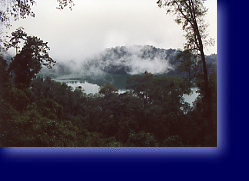 I stayed for an hour and one-half and began my return. On
the way back up to the crest of the volcano, I stopped at a viewpoint I had seen on the
way in. I stood there for a while, dreaming and gazing hypnotically as the light
constantly changed over that huge jade medallion. Finishing off all but two frames of the
roll of film in my camera, I headed out. I had never seen anything like this and knew it
was a very significant, mystical place. Later, I was to learn that the indigenous people
hold important spiritual ceremonies here in May of each year. I was not surprised. The
bowl at the top of the world had a potent, magnetic quality that completely engulfed,
nourished, and freed me. I stayed for an hour and one-half and began my return. On
the way back up to the crest of the volcano, I stopped at a viewpoint I had seen on the
way in. I stood there for a while, dreaming and gazing hypnotically as the light
constantly changed over that huge jade medallion. Finishing off all but two frames of the
roll of film in my camera, I headed out. I had never seen anything like this and knew it
was a very significant, mystical place. Later, I was to learn that the indigenous people
hold important spiritual ceremonies here in May of each year. I was not surprised. The
bowl at the top of the world had a potent, magnetic quality that completely engulfed,
nourished, and freed me.
On the way down, I came across five men working the maize
field in the shallow valley between the mountain and the crest of the volcano. They called
out for me to wait for them, and I began to get nervous when I realized that no one knew I
had come here today. I eventually stopped when they began jogging toward the road,
accepting that there was nothing I could do if they wanted my camera, or watch, or
who-knows-what. We greeted each other and sheepishly I learned that they simply wanted to
walk back to San Martín with me. The friendly guys turned out to be full of beautifully
devilish humor. They asked where I was from and I told them California. One guy said,
"¿Coliflor?" (cauliflower), which we all found hysterical. This turned
into a superb game of making up many ridiculous jokes using different words in absurd
contexts.
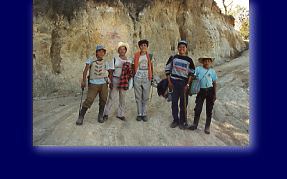 At one point, they asked me to take
their picture. I told them I had only two more frames on my roll. They kept insisting and
finally I asked why--most likely, they would never see it, since I didn't know if I would
ever be able to return to San Martín. One grinned and simply said, "Because it's
fun!" We laughed and I consented. Not realizing until after I saw the print, we had
stopped in a curve of the road that was nothing more than an area where a bulldozer had
cut the road. In a spectacular landscape that looks like The Sound of Music goes to
Guatemala, I had taken a picture of these wonderfully boisterous campesinos in a
fairly unsightly setting. Oh well. They ended up taking a shorter route around the village
in the valley where the trek began, to the main road to catch the bus. I made it back to
San Martín Sacatepéquez in a little over half the time it had taken to climb to the
lagoon. At one point, they asked me to take
their picture. I told them I had only two more frames on my roll. They kept insisting and
finally I asked why--most likely, they would never see it, since I didn't know if I would
ever be able to return to San Martín. One grinned and simply said, "Because it's
fun!" We laughed and I consented. Not realizing until after I saw the print, we had
stopped in a curve of the road that was nothing more than an area where a bulldozer had
cut the road. In a spectacular landscape that looks like The Sound of Music goes to
Guatemala, I had taken a picture of these wonderfully boisterous campesinos in a
fairly unsightly setting. Oh well. They ended up taking a shorter route around the village
in the valley where the trek began, to the main road to catch the bus. I made it back to
San Martín Sacatepéquez in a little over half the time it had taken to climb to the
lagoon.
* * *
While waiting
for the bus to come down the road on its way to Xela, I met an old man in one of those
beautiful tunics. We sat in silence on a log for quite a while as I contemplated whether
to ask if he would allow me take his picture. I finally decided against it, thinking it a
little too invasive. Instead, I asked what language the people spoke in San Martín
because I couldn't understand it. I said it sounded like Chinese and he said, "¿De
China?"
"Yes, from China." I saw that he was having difficulty, so
offered, "It is a country across the ocean."
Uncertainly, he said slowly, "China, oh, oh yes… China."
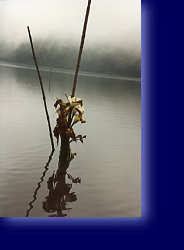 He then let me know that the language was Mam, a Mayan dialect, and asked where I was
from. I told him I was from the United States. He then let me know that the language was Mam, a Mayan dialect, and asked where I was
from. I told him I was from the United States.
"Oh, the United States!"
"Yes. I come from a state called California."
"Hmmm."
"And the name of my city is San Francisco."
"Oh yes," he said, "We have San Francisco here."
"True," I replied, "San Francisco El Alto. They say it
is very pretty there."
"Yes, that's right."
We spoke briefly of the friendliness of the Guatemalan people and the
beauty of the country. He finally asked what language we spoke in my city. I told him that
most of the people speak English, and that many Latinos speak Spanish. I knew from how he
had responded to China that he would probably not understand the myriad of Asian languages
heard in San Francisco. I settled on saying there were also people from Japan who spoke
Japanese. He looked at me quizzically and I said, "Yes, they are from Japan."
("de Japon.")
He faltered again with uncertainty, slowly repeating, "Japon."
I felt at a loss and slightly helpless. I explained that it was another country across the
ocean.
"So you don't speak Mam in your city?"
"No," I answered carefully, "We don't have that language
in my city. This is the first time I have heard it."
He sat very still for a few moments, staring off into the distance.
Then, very gradually, he lifted his index finger in an arc to his chin, nodding slowly,
and said, "Hmmmmm."
|